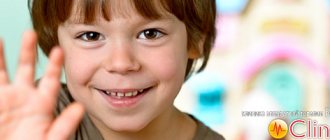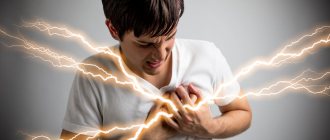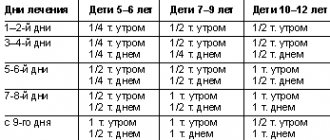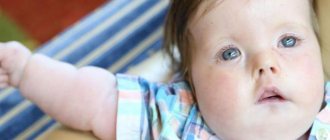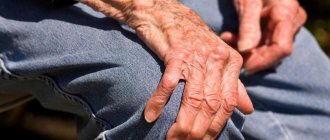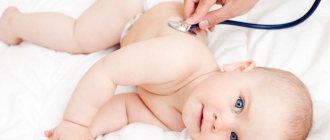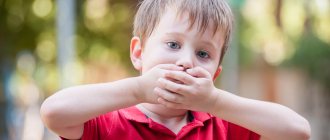Psychological disorders such as neuroses are often found in children. The largest number of cases of disorders is recorded in the age group that includes schoolchildren and adolescents.
Neurasthenia manifests itself in irritable weakness. The child may have a tendency to react with anger or irritation, as well as instability in the face of various mental stresses. Neurotic disorders are often accompanied by autonomic disorders. Vascular fainting, appetite and sleep disturbances, frequent vomiting and headaches may occur.
Factors that can increase the risk of neurotic disorders are:
- excessive loads. Physical activities can also cause neurosis, but first of all you need to beware of intellectual overload. Classes in specialized schools with various specializations, visiting various clubs and sections after school - all this can provoke the appearance of asthenic neurosis in a child;
- unfavorable family environment, quarrels and divorce of parents;
- mistakes of parents in the educational approach. Excessive demands, the presence of unnecessary and strict restrictions.
Teenagers are most susceptible to the development of neuroses. This is due to the characteristics of this age period. Difficult relationships with peers at school and acute conflict situations can have a negative impact on the fragile psyche of a child.
Classification of neurotic disorders in children
Neuroses in children
Asthenic neurosis (neurasthenia)
It is formed in children who are timid and suspicious.
Often occurs after long-term infectious diseases, against the background of chronic stress or overwork. Neurosis is manifested by sleep disorders, anxiety, and unreasonable fears. The patient develops inadequate sensitivity to familiar stimuli: noise, bright light. Somatic symptoms include headaches, discomfort in the heart, and gastrointestinal disorders. Vegetative components are often added: goosebumps, chills, sweating.
Hysterical neurosis
Children with traits of demonstrativeness, publicity, and infantilism are prone to hysterical neurosis. At an early age, disturbances in physiological functions (affective-respiratory attacks, involuntary bowel movements and urination), falling to the floor screaming, are typical.
Children with normal speech development develop symptoms of mutism - lack of response in dialogue, reluctance to engage in verbal contact. For older people and teenagers, a vivid picture of hysteria is typical: theatricality, arching in non-physiological positions, loud emotional sobbing. Less commonly, convulsions and hysterical blindness may occur.
Obsessive-compulsive disorder
Among the sick, children with increased moral responsibility are more common. Patients are usually distinguished by pedantry, adherence to principles, and meticulousness. The child is haunted by obsessive experiences and phobias, which he himself wants to get rid of: fear of death, war, separation from parents.
There is an obsessive component, which is realized by convulsive spasms, obsessive movements (blinking, coughing, wrinkling the forehead). Children have “calming” rituals, for example, sucking the edge of a pillow, washing their hands for a long time.
Depressive neurosis
It often develops as a result of the action of a constant psychotraumatic factor in the family. Adolescents and children at puberty are more prone to depressive neurosis. The child is withdrawn, wants to be alone, and is constantly in a depressed mood. Speech becomes scanty, the face becomes hypomimic. Characterized by decreased physical activity, poor appetite, and insomnia.
Systemic (asymptomatic) neuroses
The group includes a number of diseases that are represented by individual manifestations. One type is tics or tic movements. Neurosis looks like periodic twitching of the eyelids, facial muscles, limbs or torso as a whole. Loss of control over urination (enuresis) or bowel movements (encopresis) also falls into this category. A representative of systemic neurosis is logoneurosis, or neurotic stuttering, in which disturbances in the rhythm and fluency of speech in children are associated with spasms of the speech muscles.
Treatment and prevention of neurotic disorders in children
Correction of such mental conditions as neurotic disorders in children is carried out comprehensively. In this case, consultation with various specialists is necessary. Only with the joint work of a pediatrician, neurologist, psychologist and psychiatrist is successful treatment of the disorder possible.
The participation of parents is of great importance in normalizing the mental state of the child. They should notice changes in the child’s behavior and immediately contact specialists. It is important to understand that ignoring such a dangerous disease as neurasthenic disorder can lead to even more serious conditions. Therefore, it is important to start treatment as early as possible. The Psychoendocrinology Center employs experienced specialists who apply the latest achievements in the field of psychiatry and psychology in their practice.
During the treatment process, much attention is paid to psychotherapeutic measures. Family psychologists at the Center work not only with young patients, but also with their parents and other family members. Medicines can also be used to correct neurotic disorders in children. They are prescribed in extreme cases, when taking medications is justified by the patient's condition.
Neurosis is a dangerous and insidious disease; a lot of effort must be made to completely cure it. It is much easier to prevent the appearance of neuroses. The risk group includes impressionable children who are prone to various kinds of anxiety and fears. Parents should pay attention to the child and his needs, and if the first signs of neurotic disorders appear, contact the specialists of the Psychoendocrinological Center. All patients are guaranteed complete confidentiality!
Causes of childhood neurosis
Modern psychology interprets neurotic disorders as an internal, personal conflict . In other words, a person cannot adequately react and survive any mentally traumatic situation. A child who discovers something new every day is very impressionable; real events and experiences are closely intertwined with the imaginary world. First of all, children turn to their mother or father with problems that concern them, but not every parent will be able to distract themselves from work or some urgent matters, listen to the child and give a comprehensive answer to his questions.
The most common cause of neuroses in children is fear. In early and preschool age, fear of the dark, loneliness, and animals predominates. With the development and popularization of computer games, the cause of fear is increasingly becoming game characters, heroes of any films or cartoons (especially if parents do not pay due attention to filtering video content).
As you get older, the emphasis shifts. At the age of 6–7 years, fear of a new social environment appears, fear of getting into an awkward situation, not coping with a given task, or becoming an object of ridicule. In some cases, at this age, the so-called “school neurosis” is formed: an exaggerated fear of school and children’s groups.
In addition, the etiology of the disorder may be related to:
- intense, age-inappropriate physical and mental stress, especially if the need to study and/or play sports causes only negative emotions;
- the demands made by parents, other family members, and teachers are too high;
- indifferent attitude on the part of the father and/or mother;
- starting to attend kindergarten;
- bullying, ridicule from classmates;
- problems communicating with peers;
- poor grades at school, especially if the child cannot master any material despite carefully doing homework.
Obsessive movements or obsessive-compulsive disorder in children - what is it?
Obsessive movement syndrome is part of a whole group of neuroses united by the concept of obsessive-compulsive personality disorder.
Obsessive-compulsive disorder is a mental disorder characterized by obsession with obsessive states (thoughts, phobias, memories, doubts, actions). The patient is constantly under the yoke of anxious thoughts and fears (obsessions). For example, a child is terrified of contracting some terrible fatal disease, or it seems to him that with his thoughts he can harm someone, or he cannot calmly leave the house, because he believes that then something will definitely happen. Anxiety grows, prevails, and then, in order to somehow relieve itself, the patient performs some actions (compulsions) that, in his opinion, should prevent this or that event: constantly washes his hands; spits over his left shoulder and knocks on wood with every “bad thought”; Before leaving the house, he places things on the table in a certain order. Obsessions are characterized by their cyclical nature and involuntariness (they have a character that is alien to the patient; he does not want them to appear and fights them). The struggle (compulsion) can be direct (as in the case of washing hands), that is, directed directly against fear (I’m afraid of getting infected - wash my hands, kill germs) and indirect, not related to fear in its meaning (count to ten before leaving the house and turn on one leg counterclockwise). Such compulsions are called rituals.
Obsessive movement syndrome in children also manifests itself in involuntary, frequently repeated actions. It could be:
- grimacing;
- smacking, coughing, clicking fingers or knuckles;
- twirling hair on a finger;
- cheek twitching;
- chewing pencils, pens, nails;
- thumb sucking;
- hair pulling;
- scratching the skin;
- waving your arms;
- shoulder twitching and so on.
It is difficult to list all possible motor obsessions; they are quite variable and individual. Some of them can be confused with nervous tics, but unlike tics, which are caused by automatic muscle contraction and cannot be controlled, obsessive movements can be suppressed (though not easily) through willpower. In addition, as mentioned above, there are so-called protective rituals, which from the outside look like strange habits. For example, a child goes around all obstacles from a certain side, puts notebooks in a backpack only with his left hand, before going to bed, jumps on one leg a certain number of times, etc. The nature of such “rites” can be very complex.
Also, children suffering from obsessive-compulsive disorder are characterized by a pathological desire for order and cleanliness (meaningless moving objects from place to place, frequent hand washing).
Obsessive movements (actions) are caused by psycho-emotional discomfort, they are aimed at calming anxiety.
Principles of treatment
The basis for treating neurosis in a child is psychotherapy. Doctors at our medical center widely use various art therapy techniques (drawing, sculpting) when working with children. , fairytale therapy and group classes provide good results
Additionally, the psychologist also conducts consultations with parents. As practice shows, most often the disorder is a consequence of either an unfavorable family atmosphere or an incorrect approach to education, and without qualified help it is very difficult to change this situation.
Doctors also recommend:
- establish a clear daily routine (full sleep plays a huge role);
- reduce the intensity of physical and mental stress: perhaps it is better to refuse to attend several sports sections at once and leave one, review the schedule of additional classes with tutors, etc.;
- limit the use of gadgets: of course, it won’t be possible to completely abandon the computer, phone and tablet now, especially if we are talking about distance learning, but you should limit this time to two (maximum three) hours a day;
- walks in the open air;
- water procedures before bed (warm bath, you can add herbal decoctions);
- joint family vacation.
To normalize sleep, eliminate anxiety, and prevent outbursts of aggression, sedatives are indicated (drug treatment usually starts with “mild” drugs, and only if there is no effect from taking them, they switch to other medications), adaptogens, B vitamins, glycine. Physiotherapy treatments have proven themselves well: massage, reflexology.
You can get more detailed information from our consultants by phone 8(969)060-93-93.
Causes of obsessive movements
Shy, fearful, anxious-suspicious, overly impressionable, insecure children are predisposed to obsessive movements syndrome. The following factors can cause the development of neurosis:
- stress;
- chronic fatigue;
- psychological trauma (parental conflicts, dysfunctional family, loss of a loved one or pet, moving to a new place of residence, changing kindergarten or school, etc.);
- the appearance of another child in the family;
- dictatorial upbringing or, conversely, excessive permissiveness;
- excessive demands from parents and the inability to meet them;
- strict religious education;
- heredity;
- some diseases (tuberculosis, mononucleosis, viral hepatitis, measles)
- organic brain lesions;
- traumatic brain injury.
Diagnosis of obsessive movement syndrome in children is based on complaints from parents and observation of the patient. To make an accurate diagnosis, it is necessary to undergo a neurological, psychiatric examination, as well as psychological testing.
